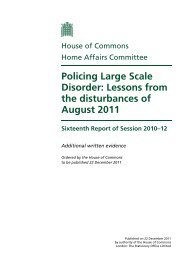Murder and Serious Sexual Assault - Lancaster EPrints - Lancaster ...
Murder and Serious Sexual Assault - Lancaster EPrints - Lancaster ...
Murder and Serious Sexual Assault - Lancaster EPrints - Lancaster ...
You also want an ePaper? Increase the reach of your titles
YUMPU automatically turns print PDFs into web optimized ePapers that Google loves.
6. Summary <strong>and</strong> conclusions<br />
SUMMARY AND CONCLUSIONS<br />
Much of the previous work on the risk of offending behaviour has focused on<br />
recidivism (i.e. the likelihood of re-offending behaviour). This study has instead<br />
focused on the likelihood of those within the general criminal population of<br />
committing their first serious offence (murder or SSA of an adult female, including<br />
rape). This chapter summarises the rationale for the study, explores what lessons<br />
may be learned <strong>and</strong> finally discusses some of the practical applications the research<br />
might have.<br />
Having an underst<strong>and</strong>ing of criminal histories is important for many of those working<br />
within the criminal justice system. There has, of course, been a long tradition of<br />
criminological work in using criminal histories to predict re-conviction <strong>and</strong> reoffending.<br />
This tradition, which began with the pioneering work of Ernest W. Burgess<br />
in Chicago in the 1920s trying to identify those who would be most appropriate to<br />
parole (Mannheim, 1965), has evolved. In the late 1990s, the Home Office developed<br />
the (revised) Offender Group Reconviction Score (OGRS). This is a statistical risk<br />
score which provides an estimate of the probability that a convicted offender will be<br />
re-convicted at least once within two years of release from custody or from the start of<br />
a community sentence (Copas <strong>and</strong> Marshall, 1998; Taylor, 1999). The Offender<br />
Assessment System, a new national system for assessing the risk <strong>and</strong> needs of an<br />
offender, represents the most recent development in this area (Home Office, 2001).<br />
This present study, however, has examined whether it is possible to look back at<br />
criminal histories to reveal something more specific about the future. It started with<br />
the idea that a more systematic study of the previous criminal history of those that<br />
had been convicted <strong>and</strong> sentenced for murder or SSA might provide an insight into<br />
patterns in very serious offending behaviour.<br />
The approach involves the language of probabilities rather than of certainties: what<br />
is the relative risk of those committing certain types of crime in the past becoming<br />
murderers or convicted of SSA? It is important to remember the general weaknesses<br />
around using conviction data as proxy for offending behaviour; through the process<br />
of attrition, successful convictions represent only a proportion of all offences<br />
committed. Moreover, this relationship varies considerably between the target<br />
offences of murder on the one h<strong>and</strong>, <strong>and</strong> rape/serious indecent assault on the other,<br />
as well as in relation to all the prior offences that make up criminal careers.<br />
Notwithst<strong>and</strong>ing the problems around using conviction data as a proxy for<br />
offending behaviour, using appropriate control groups does produce analytical<br />
rigour. It is of little use knowing that over 40 per cent of convicted murderers have<br />
39
















